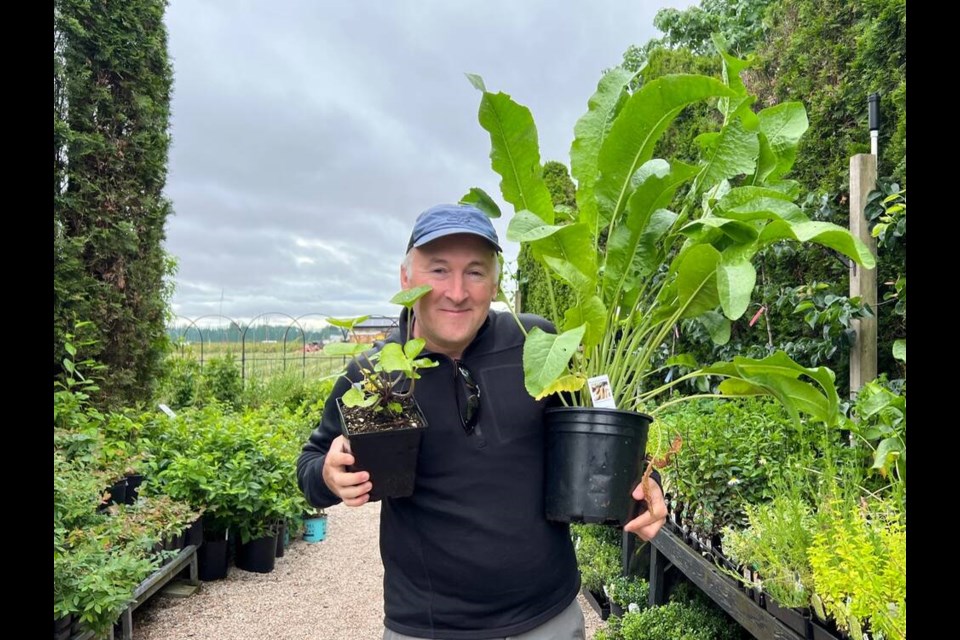A local gardener wants to help his neighbours get into gardening with three popular edible suggestions - wasabi, citrus fruit and tea.
“A lot of people are scared to plant in the summer months, you don’t have to be scared,” said Gary Lewis, author and owner of local plant nursery Phoenix Perennials.
“As long as you just pay a little of attention to watering, you can just keep going.”
Part of the reason for this fear could be due to people mixing up planting with “transplanting,” said Lewis. Transplanting means digging up a plant already in the garden and moving it to a new location, which should not be done during summer because the plant will struggle after its roots get destroyed.
Planting, on the other hand, can be done all summer long because it does not disturb the roots.
Citrus
“Citrus have become so popular with people in the last number of years,” Lewis told the Richmond News.
Part of the reason for the citrus boom, said Lewis, is a growing desire to find interesting food.
“… there are a lot of citrus that are hard to get… and foodie people have really gotten into weird ingredients and interesting ingredients.”
One such example is Australian finger limes, which are oblong-shaped fruits containing juicy beads, or caviar, instead of sections like other citrus fruits. They taste tart like limes and can be sprinkled on dishes for a fancier finish, said Lewis.
Other citrus fruits such as Meyer lemons, yuzu, sudachi, Owari mandarins and kumquats also have a strong fanbase among local citrus enthusiasts. Meyer lemons are loved for their sweetness, while sudachi is commonly used for ponzu sauce.
Fragrant citrus flowers and beautiful foliage also contribute to their popularity.
“Midsummer is a great time to get started with citrus,” Lewis told the News, adding that people can start by growing the plants in pots in sunny areas.
“You want to plant them in lots of sun with lots of heat. So, your hottest, sunniest spots are where the citrus are going to grow the best and flower the most and produce the most fruit.”
While most citrus fruit needs to be indoors during winter months, hardier varieties such as yuzu, sudachi and Owari mandarins can be left outside in protected locations all year round.
Citrus can produce fruit all through the year, with most ready for harvest during summer and fall. Some mandarins, such as Owari mandarins, will also produce fruit during the winter months.
“Within two to three years, you should be getting a lot of fruit. And within three to five years, you’ll be getting lots and lots of fruit,” he said.
The trick to planting citrus in a container is to use a “nice and chunky” soil mix with some extra bark rather than a “heavy” soil mix with compost. Since citrus plants are “pretty heavy feeders,” Lewis also recommends adding fertilizers with high nitrogen.
Tea
Another edible plant to check out this summer is the tea plant, which, like the big colourful flowers, is also a species of evergreen shrubs called Camellias.
“Every type of tea comes from just this species (of tea plant),” said Lewis. It’s an easy plant to grow with no diseases or bugs affecting it.
While there are different cultivars of the tea plant, the main things differentiating green tea, black tea and oolong tea are the way the leaves are processed after they have been harvested and how old the leaves were when they were picked.
Lighter teas such as green teas and oolong teas would go through less processing, while black tea might involve rolling the leaves to bring out the tannins followed by roasting.
When planting new shrubs such as tea plants (and trees) during summer, Lewis recommends using the “bowl method.” Simply dig a hole, make a dam around the plant with the extra soil and fill the hole with water, which allows the water to go straight down to the roots.
Tea plants can be grown in containers or in semi-covered areas of the garden, as long as they’re not in deep shade. For those needing more privacy from one’s neighbours, they can also be grown as hedges.
Tea leaves can be harvested any time of the year, as long as new leaves are being produced. Tea plants are usually harvested at the three-leaf stage, said Lewis, and old leaves should be avoided because they become too hard and thick.
“Anybody can grow their own tea in their garden, collect their own leaves, do a little bit of reading on the internet to look at the different ways to treat the leaves… and make their own tea.”
Wasabi
“One thing that a lot of people don’t realize is that when you go to a sushi restaurant, and you get a ball of wasabi on the side, that’s not wasabi,” said Lewis.
“That’s horseradish that they dyed green.”
Although the two share a similar hot and spicy taste, real wasabi is followed by a “long, mellow finish” that is more refined and less intense than its horseradish counterpart.
The reason for this practice, he explained, is that wasabi is slow to grow and “very expensive to produce.”
Harvesting wasabi involves taking out the whole trunk and grating the trunk. The top of the plant, with the leaves, can then be replanted for the future. Since wasabi oxidizes and turns brown, it should be grated and eaten fresh.
For those with shady gardens, wasabi would be a great option for summer planting. It can be planted in pots, but it also does well in the garden.
“The important thing to know is it wants a lot of water,” said Lewis.



